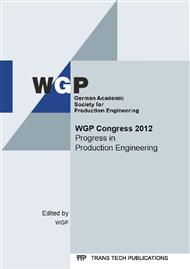p.379
p.391
p.405
p.417
p.427
p.439
p.455
p.463
p.475
Development of a Numerical Method for Prediction of Wear on Shear Cutting Tools
Abstract:
The shape of cutting edge and cutting geometry changes in tool life due to wear. These geometrical changes of the tool are leading to non acceptable deviations from the demanded target geometry and a loss of cutting surface quality. Consequently the tool has to be inspected at regular intervals and be replaced or grinded if necessary. Prediction of such inspection intervals emerge as one of the challenges for an effective production. The inspection interval is dependent on tool life, which can be determined by cost intensive and elaborate experiments. Determination of a database containing tool life data for different production conditions actually lead to excessive waste of material and energy. Due to this fact, this paper presents a new procedure to predict the wear behavior of shear cutting tools based on a modified Archard wear model linked with finite element analysis (FEA). The Archard equation requires an empirical adjustment factor K. The intention of this paper is to highlight a potential approach to determine this coefficient without conducting long lasting tool life tests. A design method oriented approach in this paper is leading to a procedure to be able to determine wear coefficient using a chip cutting process. Though this adjustment can be accomplished within a few hours (time required for tool life test normally needs 14 days or more) with a material usage of only 0.5 % of the required sheet metal material compared to corresponding shear cutting tests. In future practitioners might look for accurate prognosis of amount of tool wear in order to reduce machine downtime and discarded parts significantly what finally saves energy, time and material.
Info:
Periodical:
Pages:
427-438
Citation:
Online since:
April 2014
Authors:
Price:
Сopyright:
© 2014 Trans Tech Publications Ltd. All Rights Reserved
Share:
Citation:


